Maqam Ibrahim: A Testament to Prophet Ibrahim's Legacy
In the heart of the holiest sanctuary on Earth lies a stone of profound significance, revered by millions of believers. This stone, known as Maqam Ibrahim, stands as a testament to the unwavering faith and dedication of Prophet Ibrahim (Abraham) - عليه السلام - as he and his son Ismail (Ishmael) - عليه السلام - undertook the monumental task of constructing the Kaaba. With the imprints of Ibrahim's feet etched into its surface, this sacred relic has endured the passage of centuries, symbolizing a timeless connection between the past and the present.
Maqam Ibrahim, which literally means standing-place of Ibrahim, is a gem from the gems of Paradise, as our Prophet Muhammad - صلى الله عليه وسلم - said: "The Rukn (corner) and Maqam are two gems from Paradise, whose light has been extinguished by Allah. If their light had not been extinguished, they would illuminate everything between the East and the West." The Maqam is located in front of the door of the Kaaba, approximately 10-11 meters from the eastern side of the Kaaba, in the direction of Safa and Marwa.
The Maqam is a historical stone on which the Prophet Ibrahim - عليه السلام - stood while building the Kaaba when the structure was elevated. He stood on it, and his son Prophet Ismail - عليه السلام - handed him stones to place by hand to raise the wall. Whenever he completed a side, he moved to the next, circling the Kaaba and standing on it. Each time a wall was finished, he moved it to the next side until the four walls of the Kaaba were built.
The Maqam is square-shaped, with the footprints of Prophet Ibrahim - عليه السلام - in the middle, which are two oval-shaped depressions. Its color is between white, black, and yellow, and its width, length, and height are all 50 cm.
Authentic References on Maqam
وَإِذْ جَعَلْنَا الْبَيْتَ مَثَابَةً لِّلنَّاسِ وَأَمْنًا وَاتَّخِذُوا مِن مَّقَامِ إِبْرَاهِيمَ مُصَلًّى ۖ وَعَهِدْنَا إِلَىٰ إِبْرَاهِيمَ وَإِسْمَاعِيلَ أَن طَهِّرَا بَيْتِيَ لِلطَّائِفِينَ وَالْعَاكِفِينَ وَالرُّكَّعِ السُّجُودِ ( البقرة125)
"And as We made the House a resorting place for mankind and a (place of) security, and take to yourselves Ibrahim's Maqam (Standing Place) for a place of prayer. And We covenanted with Ibrahim and Ismail, (saying), "Sanctify My House for those who are circumambulating it (performing tawaf), or staying (I'tikaf), or bowing or prostrating themselves (there, in prayer”
Ibn Kathir said:
"The 'Maqam' refers to the stone upon which Ibrahim - عليه السلام - stood while building the Kaaba. When the wall rose, Ismail - عليه السلام - brought him the stone so he could stand on it and hand Ibrahim the stones to place them higher on the wall. Each time a side was completed, they moved to the next, circling the Kaaba. The footprints of Ibrahim were visible on the stone, and this was known to the Arabs in pre-Islamic times”.
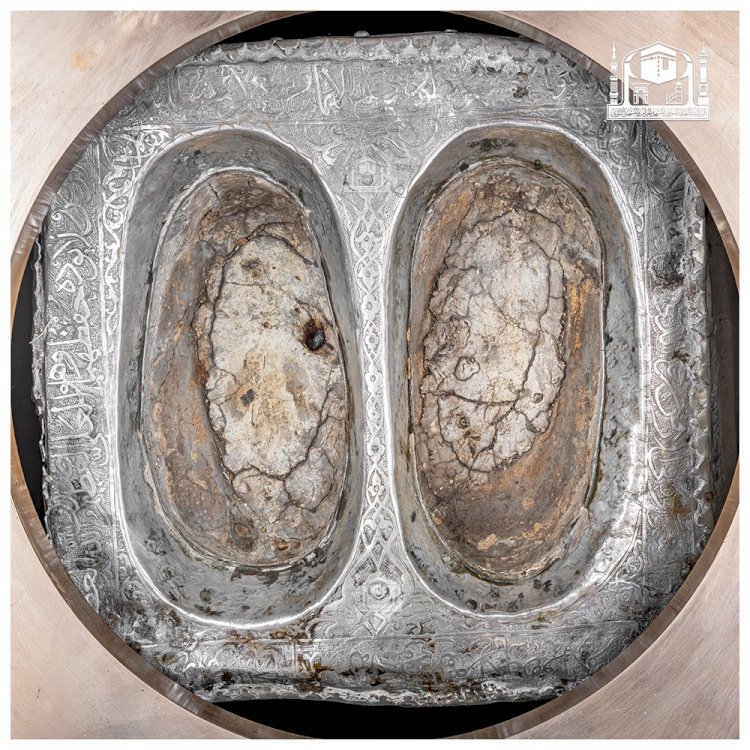
Hiqhquality image of Maqam Ibrahim released by Haramain Authority in 2021
The story of Ibrahim and Ismail building the Kaaba and Ibrahim standing on the Maqam is narrated in Sahih Bukhari through a lengthy Hadith by Ibn Abbas - رضي الله عنهما:
"... Then Ibrahim said: 'O Ismail, Allah has commanded me with something.' Ismail responded, 'Do what your Lord has commanded you.' Ibrahim asked, 'Will you help me?' Ismail replied, 'I will help you.' Ibrahim said, 'Allah has commanded me to build a house here,' and he pointed to a high mound. They both then raised the foundations of the House, with Ismail bringing the stones and Ibrahim building. When the structure rose, he placed the stone for Ibrahim to stand on, and Ismail handed him the stones. They both continued building around the house, praying:
رَبَّنَا تَقَبَّلْ مِنَّا ۖ إِنَّكَ أَنتَ السَّمِيعُ الْعَلِيمُ (127)
"Our Lord, accept [this] from us. Indeed, You are the Hearing, the Knowing."' (Al-Baqarah 2:127)
Ibn Hajar Al-Asqanali said: "Maqam Ibrahim refers to the stone that bears the marks of his feet."
Ibn Kathir further adds:
"The marks of his feet were visible on the stone, and this was known to the Arabs in the pre-Islamic period. Muslims also recognized it, as Anas bin Malik said: 'I saw the stone with the marks of his fingers and the soles of his feet.'
However, these marks were erased by people rubbing them with their hands. Ibn Jarir narrated from Qatadah, who said: 'And take the standing place of Ibrahim as a place of prayer.' They were commanded to pray at it, not to rub it. This nation has taken up practices not taken up by previous nations. It has been mentioned to us that some saw the marks of his heel and toes on it, but this people kept rubbing it until they disappeared," as stated in Tafsir Ibn Kathir (1/117).
In this blessed stone lies the miracle of the footprints of Ibrahim (peace be upon him), where Allah made the stone beneath his feet soft like clay, allowing his feet to sink and leaving their marks visible until today. The footprints have changed from their original form due to people touching them over the centuries before the Maqam was enclosed.
Anas (may Allah be pleased with him) said: "I saw the Maqam with the fingers and soles of Ibrahim’s feet, but the people’s touching erased it."
The Prophet Muhammad (peace be upon him) likened his feet to those of Ibrahim, saying: “I saw Ibrahim and I am the most resembling of his children to him.” (Sahih Bukhari).
The noble companion Abu Juhm bin Hudhayfah Al-Qurashi Al-Adawi said: "I have not seen a resemblance like the resemblance of the Prophet’s feet to Ibrahim’s, which we used to find in the Maqam."
Virtues of Maqam Ibrahim
- Mentioned among Allah’s clear signs: Allah mentioned Maqam Ibrahim among His clear signs in the Quran:
"Indeed, the first House [of worship] established for mankind was that at Makkah - blessed and a guidance for the worlds. In it are clear signs [such as] the standing place of Abraham. And whoever enters it shall be safe. And [due] to Allah from the people is a pilgrimage to the House - for whoever is able to find thereto a way. But whoever disbelieves - then indeed, Allah is free from need of the worlds." (Al-Imran 3:96-97)
Ibn Jarir commented: "The first House placed for people was blessed and a guidance for the worlds, with clear signs including the mark of Ibrahim's feet in the stone."
- Commanded as a place of prayer: Allah commanded Muslims to take it as a place of prayer during Hajj and Umrah in the previous mentioned Quran verse of Al-Baqara 125.It is narrated that when the Prophet ﷺ and Umar I passed by the Maqam, Umar asked if it was the shrine of their father, Ibrahim. The Prophet ﷺ confirmed it was. Umar then suggested making it a place of prayer. The Prophet ﷺ responded that he had not been commanded to do so. However, before sunset that day, the verse was revealed: “And take the Maqam Ibrahim as a place of salah.” (Quran 2:125).
- A gem from Paradise: Imam Ahmad, Tirmidhi, Ibn Khuzaymah, Ibn Hibban, and Hakim reported from Abdullah bin Amr bin Al-As - رضي الله عنهما - that the Prophet - صلى الله عليه وسلم - said: "The Rukn (corner) and Maqam are two gems from Paradise, whose light has been extinguished by Allah. If their light were not extinguished, they would illuminate everything between the East and the West."
- Ibrahim stood on it to proclaim Hajj: Fakihi (AH 275), a famous historian of third century Hijiri, narrated from Ibn Abbas - رضي الله عنهما - that the Prophet - صلى الله عليه وسلم - said: "When Ibrahim finished building the House, Allah commanded him to proclaim Hajj. He stood on Maqam and called out: 'O people, your Lord has built a house, so perform Hajj to it.' People responded from the loins of men and wombs of women: 'Here we are, O Allah, here we are.' Every person who performs Hajj today is among those who responded to Ibrahim's call."
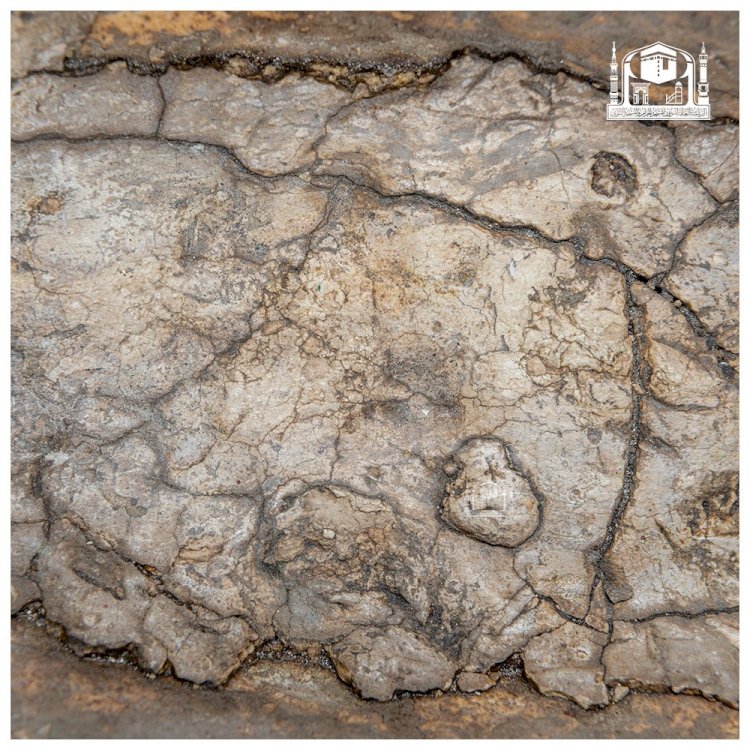
The close up image of the stone (Maqam Ibrahim) on which prophet Ibrahim stood whiling building kaaba
Historical Account of Maqam Ibrahim
Scholars have differed on whether Maqam Ibrahim was in its current location during the time of Ibrahim and Muhammad (peace be upon them), or was it adjacent to the Kaaba during their time? presenting two main opinions:
First Opinion: Maqam Ibrahim was adjacent to the Kaaba, and Umar - رضي الله عنه - moved it from its original place. This view is narrated from Salim bin Abdullah bin Umar and Saeed bin Jubair, and it is also chosen by the scholars Ibn Hajar Fath al-Bari (8/169) and Ibn Kathir Tafsir Ibn Kathir (1/170).
Malik bin Anas said: "It has reached me that when Umar bin Al-Khattab (may Allah be pleased with him) became caliph and performed Hajj, he entered Mecca and moved the Maqam to its current location. It had been adjacent to the Kaaba during the time of the Messenger of Allah (peace be upon him), during the time of Abu Bakr (may Allah be pleased with him), and even before that. They had moved it during the pre-Islamic period out of fear that the flood would carry it away. When Umar became caliph, he took out a measuring string that was in the Kaaba’s treasury, which they had used to measure the distance between its place and the Kaaba when they moved it due to fear of the flood. Umar measured it and moved it back to its current position. This is its location from the pre-Islamic period and the time of Ibrahim (peace be upon him)." (Malik bin Anas, "Al-Mudawwanah," 1/456.
Second Opinion: Maqam Ibrahim was in its current location from the time of Prophet and was not moved by Umar - رضي الله عنه -. This view is supported by Urwah bin Zubair, Imam Malik, Abdullah bin Ubaydullah bin Abi Mulaika, Al-Azraqi "Akhbar Makkah" (2/33), Al-Fasi Muthir al-Gharam" (1/205) , Al-Fakihi "Akhbar Makkah" (1/454), Muhibb al-Din al-Tabari "Al-Qura li-Qasid Umm al-Qura" (p. 346). Imam An-Nawawi also support this view Tahdhib al-Asma wa al-Lughat" (3/155).
The below narration support this view.
Kuthayyir bin Kuthayyir bin al-Muttalib bin Abi Wada'ah al-Sahmi narrated from his father, from his grandfather - رضي الله عنه -:
"Floods used to enter the Haram Mosque from the large gate of Banu Shaybah before Umar bin al-Khattab - رضي الله عنه - filled the upper gap. This gate was known as the Gate of the Flood. The floods would sometimes move the Maqam from its place, pushing it towards the Kaaba. This happened during the caliphate of Umar when a flood, known as the Flood of Umm Nahshal, occurred. It swept away Umm Nahshal, the daughter of Ubaydah bin Abi Uhayhah Sa'id bin al-As, who drowned. The flood carried the Maqam from its place, and it was found in the lower part of Mecca. It was brought back and tied to the curtains of the Kaaba.
Umar - رضي الله عنه - received news of this and hurriedly came to Mecca, entering with the intention of performing Umrah in the month of Ramadan. He found that the place where the Maqam stood had been obscured by the flood. Umar called the people and asked, 'Does anyone have knowledge of the Maqam's location?' Al-Muttalib bin Abi Wada'ah al-Sahmi replied, 'I do, O Commander of the Faithful. I feared for this and took its measurements from its location to the corner, from its location to the gate of the Hijr, and from its location to Zamzam with a measuring tape, and I have it at home.' Umar said to him, 'Sit with me,' and sent for the measuring tape. It was brought and stretched out, and it was found to be exactly in its place. Umar asked the people and consulted them, and they agreed that this was its place. Umar then ordered for it to be fixed with a construction beneath the Maqam, securing it in its place, where it remains to this day." This narration is found in Al-Azraqi's "Akhbar Makkah" (2/33).
Many narrations indicate that Maqam Ibrahim was kept adjacent to the Kaaba and it was the Prophet - صلى الله عليه وسلم - who changed its location at the time of the Fath Makkah. Mujahid reported that Maqam Ibrahim was initially next to the Kaaba. Umar ibn al-Khattab suggested to the Prophet Muhammad (peace be upon him) to move it to allow people to pray towards it, which he did, leading to the revelation of the verse, "And take the Maqam of Ibrahim as a place of prayer" (Al-Baqarah: 125). Ibn Jurayj noted that during a flood, the Maqam was displaced and later restored to its original position by Umar. Musa bin Uqba also mentioned that the Prophet moved the Maqam during the conquest of Mecca to its current location, where it remains today.
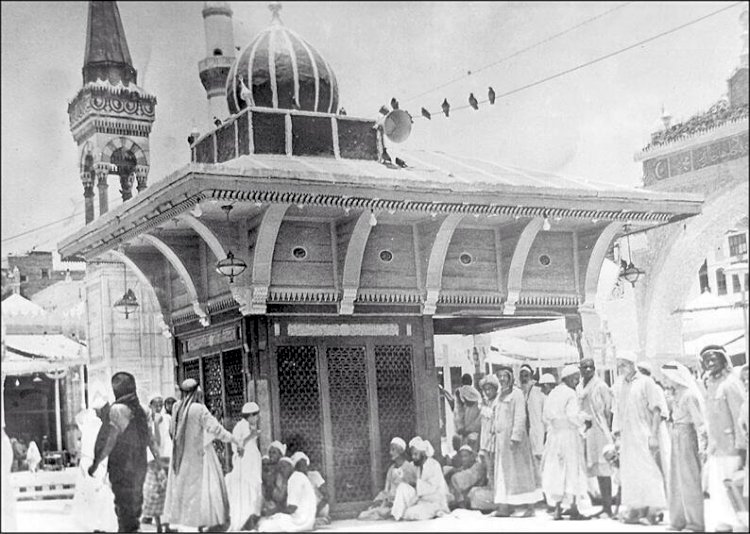
The strucure of Maqam Ibrahim before it was removed in 1967
Pre-Saudi Period
During the Abbasid era, significant efforts were made to preserve and enhance Maqam Ibrahim. Abu Ja’far al-Mansur, the second Abbasid Caliph, was among the first to build a dome over the Maqam.
In 160 AH (776 CE), during Caliph al-Mahdi's pilgrimage, Abdullah ibn Uthman ibn Ibrahim al-Hajabi brought the Maqam to al-Mahdi’s residence, where it was honored and cleansed with Zamzam water. In 161 AH (777 CE), the Maqam cracked and was repaired with gold reinforcement sent by al-Mahdi. It was placed on a granite base, a practice that continues.
In 236 AH (850 CE), Caliph al-Mutawakkil adorned the Maqam with additional gold. In 241 AH (855 CE), lead sheets covering the Maqam's "chair" were replaced with silver, and it was covered with a teakwood cupola. In 251 AH (865 CE), the gold added by al-Mutawakkil was removed to fund a war, but al-Mahdi's additions were retained. By 256 AH (870 CE), the Maqam needed further renovation, and additional layers of gold and silver were added before it was carefully returned to its place. This restoration earned praise from Caliph Al-Mu’tamid.
Initially left unprotected, the Maqam was targeted during the Qarmatian attack on Mecca in 317 AH (929 CE). Quick-thinking servants concealed it, prompting the construction of protective domes made of wood and iron, and a casket for housing the Maqam.
As the need for a permanent structure became apparent, a dedicated enclosure was built in 810 AH (1408 CE). Featuring a canopy extending towards the Maqam, it provided space for performing two rak’ahs of prayer. Over time, it underwent various restorations by different sultans and benefactors, ensuring its preservation and reverence.
Saudi Era
In 1954 CE (1373 AH), there was a proposal to move Maqam Ibrahim to ease the flow of pilgrims during Tawaf. Sheikh Al-Shaarawy, then a professor at the College of Sharia in Makkah, opposed this move on Sharia grounds. He contacted scholars and sent a detailed five-page telegram to King Saud, highlighting the sanctity and historical significance of the Maqam's location, referencing Umar ibn al-Khattab's actions. Upon receiving the telegram, King Saud convened a meeting with scholars who unanimously agreed with Al-Shaarawy. Consequently, King Saud decreed that the Maqam should remain in its original place and initiated studies to expand the Mataf area, leading to the proposal of encasing the stone in an unbreakable glass dome.
During King Faisal bin Abdulaziz's reign, measures were taken to enhance the surroundings of Maqam Ibrahim. On 25th Dhul-Hijjah 1384 AH (March 16, 1965 CE), the Muslim World League proposed removing surrounding structures to improve safety and visibility. King Faisal approved the proposal, and by Rajab 1387 AH (November 1967 CE), a high-quality crystal cover was crafted for the Maqam, surrounded by an iron barrier and a marble base measuring 180 by 130 centimeters, standing at 75 centimeters high. This change freed up 15.6 square meters of the Mataf area, improving the Tawaf experience for pilgrims.
During the reign of King Fahd bin Abdulaziz, the Maqam was renovated. The metal structure was replaced with a new one made of high-quality brass, and an inner gold-plated mesh was installed. The concrete base, previously made of black granite, was replaced with a new base made of pure white Carrara marble adorned with green granite to match the marble of the Hijr. The crystal cover is dome-shaped like a hemisphere, weighing 1.750 kg, with a height of 1.30 meters, a lower diameter of 40 cm, a thickness of 20 cm on all sides, an outer diameter at the base of 80 cm, and a circumference at the base of 2.51 meters. These improvements made the Maqam's structure streamlined, as it was polygonal before.
The actual stone of the Maqam Ibrahim is entirely encased in a silver alloy case. The Saudi authorities chose to display a deep imprint of two feet on this silver casing.
Thus, the Maqam stone itself is not visible within the glass housing. Instead, a silver encasement covers it, featuring artificial imprints meant to represent the original ones. This arrangement aims to protect the Maqam while allowing pilgrims to venerate the site, though it does not offer an authentic view of the stone or its true imprints.
Maqam Ibrahim stands as a significant relic, embodying the legacy of Prophet Ibrahim's dedication in building the Kaaba. Its preservation and enhancement reflect the continued reverence and importance given to this sacred site.
Disclaimer
The views expressed in this article are the author’s own and do not necessarily mirror Islamonweb’s editorial stance.

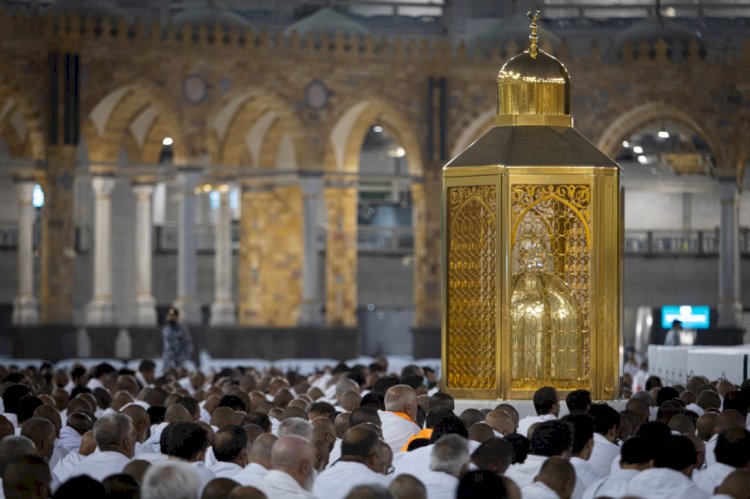




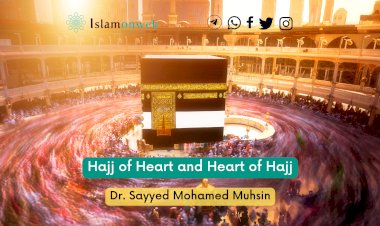


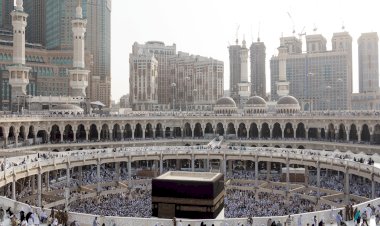














Leave A Comment